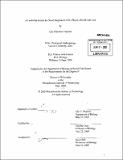A lentiviral screen for novel regulators of IL-7R[alpha] in a pre-B cell line
Author(s)
Trajman, Lily Christine
DownloadFull printable version (42.20Mb)
Other Contributors
Massachusetts Institute of Technology. Dept. of Biology.
Advisor
Jianzhu Chen.
Terms of use
Metadata
Show full item recordAbstract
IL-7R[alpha] is one component of the heterodimeric IL-7R[alpha] receptor, and signaling through this receptor is essential for murine T and B cell development as well as human T cell development. IL-7R[alpha] signaling is also responsible for homeostatic proliferation of T cells in lymphopenic hosts, as well as maintenance of naïve and memory CD8+ T cells in the periphery. A number of regulators of IL-7R[alpha][alpha] have been identified, but the complex processes underlying fine control of IL-7R[alpha][alpha] expression are poorly understood. The RNAi Consortium's lentivirus-based shRNA library targeting murine kinases and phosphatases has allowed large scale screening for modulators of IL-7R[alpha][alpha] surface expression. This library provides shRNAs in the pLKO. 1 lentiviral vector targeting 1278 known kinases and phosphatases. Analysis of the FACS-based assay identified 38 potential regulators of IL-7R[alpha][alpha] in a pre-B cell line. Subsequent validation of five of the hits confirmed known pathways of IL-7R regulation and also pointed to new potential points of regulatory control. Phosphoinositide 3-kinase (PI3K) regulates a number of cell signaling pathways that promote survival, proliferation and increased metabolism. In mammals the Class I family of PI3Ks consists of four different catalytic subunits, which can pair with any of six different regulatory subunits. PI3K was recently shown to regulate the expression of the interleukin-7 receptor alpha chain (IL-7R[alpha][alpha]) via the Foxol transcription factor. (cont.) Because IL-7R signaling is vital for murine B and T cell development, cells use a variety of mechanisms to maintain tight control of the expression of IL-7R[alpha][alpha]. Here we utilize sequential knockdown of the four Class I PI3K catalytic subunits to demonstrate that each plays a distinct role in separate pathways leading to the activation of Akt and the expression of total Foxol protein.
Description
Thesis (Ph. D.)--Massachusetts Institute of Technology, Dept. of Biology, 2009. In title on title page, [alpha] appears as lower case Greek letter. Includes bibliographical references.
Date issued
2009Department
Massachusetts Institute of Technology. Department of BiologyPublisher
Massachusetts Institute of Technology
Keywords
Biology.